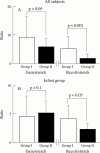Relation of biophysical response of coarcted aortic segment to balloon dilatation with development of recoarctation following balloon angioplasty of native coarctation
- PMID: 9616352
- PMCID: PMC1728649
- DOI: 10.1136/hrt.79.4.407
Relation of biophysical response of coarcted aortic segment to balloon dilatation with development of recoarctation following balloon angioplasty of native coarctation
Abstract
Objective: To evaluate the role of biophysical response of the coarcted segment to balloon dilatation in the causation of aortic recoarctation.
Setting: Tertiary care centre/university hospital.
Design: Retrospective case series.
Methods: Records of 67 consecutive infants and children undergoing balloon angioplasty of native aortic coarctations were examined for an 8.7 year period ending September 1993. At 12 months (median) follow up catheterisation, 15 (25%) of 59 children developed recoarctation, defined as a gradient > 20 mm Hg. Stretch (balloon circumference--preballoon coarcted segment circumference/preballoon coarcted segment circumference), gain (postballoon coarcted segment circumference--preballoon coarcted segment circumference), and recoil (balloon circumference--postballoon coarcted segment circumference) were calculated from measurements obtained from cineangiograms performed before and immediately after balloon dilatation.
Results: The stretch in 44 children without recoarctation (2.18 (1.23)) was similar (p > 0.1) to that in 15 children with recoarctation (1.90 (0.65)), implying that similar balloon dilating stretch was applied in both groups. Greater gain (p < 0.05) was observed in the group without recoarctation (8.8 (8.0) mm) than in the recoarctation group (5.7 (2.7) mm) but this was not substantiated in the infant population. However, the recoil was greater (p < 0.001) in the group without recoarctation (5.1 (4.3) mm) than in the recoarctation group (2.1 (1.1) mm); this was also true in the infant group.
Conclusions: Greater recoil in the patients without recoarctation implies preservation of intact elastic tissue in the coarcted segment. In the recoarctation group, with less recoil, the elastic properties may not have been preserved, thereby causing recoarctation. There might be a more severe degree of cystic medial necrosis in the recoarctation group than in the no recoarctation group. This needs confirmation in future studies.
Figures

Similar articles
-
Validation of risk factors in predicting recoarctation after initially successful balloon angioplasty for native aortic coarctation.Am Heart J. 1995 Jul;130(1):116-21. doi: 10.1016/0002-8703(95)90245-7. Am Heart J. 1995. PMID: 7611100
-
Causes of recoarctation after balloon angioplasty of unoperated aortic coarctation.J Am Coll Cardiol. 1989 Jan;13(1):109-15. doi: 10.1016/0735-1097(89)90557-3. J Am Coll Cardiol. 1989. PMID: 2521225
-
Long-term follow-up results of balloon angioplasty of postoperative aortic recoarctation.Am J Cardiol. 1998 Jan 1;81(1):61-7. doi: 10.1016/s0002-9149(97)00805-9. Am J Cardiol. 1998. PMID: 9462608
-
Balloon angioplasty of aortic coarctation: a review.Clin Cardiol. 1989 Nov;12(11):618-28. doi: 10.1002/clc.4960121103. Clin Cardiol. 1989. PMID: 2531050 Review.
-
Role of balloon angioplasty in the treatment of aortic coarctation.Ann Thorac Surg. 1991 Sep;52(3):621-31. doi: 10.1016/0003-4975(91)90961-o. Ann Thorac Surg. 1991. PMID: 1832851 Review.
Cited by
-
Stent angioplasty: an effective alternative in selected infants with critical native aortic coarctation.Pediatr Cardiol. 2007 May-Jun;28(3):183-92. doi: 10.1007/s00246-006-0074-4. Epub 2007 Apr 24. Pediatr Cardiol. 2007. PMID: 17457637
-
The Journey of an Indian Pediatric Cardiologist : Dr. K. C. Chaudhuri Lifetime Achievement Award/Oration at AIIMS, New Delhi, September 2017.Indian J Pediatr. 2017 Nov;84(11):848-858. doi: 10.1007/s12098-017-2452-8. Epub 2017 Sep 27. Indian J Pediatr. 2017. PMID: 28956269
-
Balloon Dilatation in the Management of Congenital Obstructive Lesions of the Heart: Review of Author's Experiences and Observations-Part II.J Cardiovasc Dev Dis. 2023 Jul 6;10(7):288. doi: 10.3390/jcdd10070288. J Cardiovasc Dev Dis. 2023. PMID: 37504544 Free PMC article. Review.
-
Endovascular management of coarctation of the aorta.Semin Intervent Radiol. 2007 Jun;24(2):153-66. doi: 10.1055/s-2007-980052. Semin Intervent Radiol. 2007. PMID: 21326793 Free PMC article.
-
Statistical Treatment of Clinical Investigations in Pediatric Cardiology.Children (Basel). 2021 Apr 12;8(4):296. doi: 10.3390/children8040296. Children (Basel). 2021. PMID: 33921399 Free PMC article.
References
MeSH terms
LinkOut - more resources
Full Text Sources
